The Wolfman (2010)
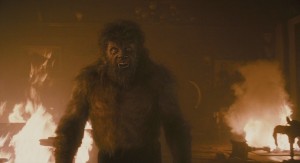 What must it be like to be stuck on a set of a movie you no longer have any faith in, but are still contractually obligated to finish?
What must it be like to be stuck on a set of a movie you no longer have any faith in, but are still contractually obligated to finish?
You know the movie is going to be derivative, tired, energy-free and mostly incoherent. But some studio head is still giving you notes about how to “improve” the film, knowing full well that his suggestions — otherwise known as compromises — are what got you here in the first place. He knows the studio will just write off the movie as a loss — but you’ll be blamed for not being able to “deliver.” All of this is happening despite the fact that you’re not given a lot of rope to hang yourself when you make a big-budget film. The reins are tight; and that’s before the all-powerful test marketing has even started.
 Such a situation isn’t necessarily what happened with Joe Johnston’s The Wolfman, a $150 million production with a lot of re-shoots and years of delays.* But one can’t help but wonder if Johnston eventually dreaded coming to set for what was probably, originally, a movie he really wanted to make. It would certainly explain the attempt to turn The Wolfman into high camp through the use of silly-looking CGI sets and buffoonish acting from those with small parts (you wouldn’t believe how long that shot above goes on, he’s literally staring directly at the camera by the end of it). And there are the editing choices that have scenes go on several beats too long, where every character eventually looks lost.
Such a situation isn’t necessarily what happened with Joe Johnston’s The Wolfman, a $150 million production with a lot of re-shoots and years of delays.* But one can’t help but wonder if Johnston eventually dreaded coming to set for what was probably, originally, a movie he really wanted to make. It would certainly explain the attempt to turn The Wolfman into high camp through the use of silly-looking CGI sets and buffoonish acting from those with small parts (you wouldn’t believe how long that shot above goes on, he’s literally staring directly at the camera by the end of it). And there are the editing choices that have scenes go on several beats too long, where every character eventually looks lost.
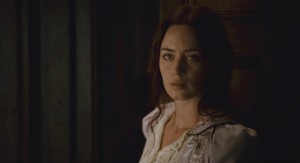 It can’t be a coincidence that all of the characters constantly talk about obligation. And Emily Blunt, as the token and inexplicable love interest, has the most telling line, “This place is impossible to escape.” This was no doubt a professional edict for those on the set. All of The Wolfman feels obligatory (even in the director’s cut, which contains an extra 15 minutes of plot points; including, “Will the widow Blunt learn how to skip rocks?”). And so there’s a significant dramatic disconnect between what we’re supposed to feel and what we actually do feel.
It can’t be a coincidence that all of the characters constantly talk about obligation. And Emily Blunt, as the token and inexplicable love interest, has the most telling line, “This place is impossible to escape.” This was no doubt a professional edict for those on the set. All of The Wolfman feels obligatory (even in the director’s cut, which contains an extra 15 minutes of plot points; including, “Will the widow Blunt learn how to skip rocks?”). And so there’s a significant dramatic disconnect between what we’re supposed to feel and what we actually do feel.
 Benicio Del Toro is well-cast to play the Wolfman character. But he has no chemistry with Blunt, his brother’s widow, who is cold and remote. I’m sure her attitude was intentional, but Del Toro, playing an arrogant Shakespearean actor eventually bitten by a wolf, is so aloof that he was unlikely to connect with anyone.
Benicio Del Toro is well-cast to play the Wolfman character. But he has no chemistry with Blunt, his brother’s widow, who is cold and remote. I’m sure her attitude was intentional, but Del Toro, playing an arrogant Shakespearean actor eventually bitten by a wolf, is so aloof that he was unlikely to connect with anyone.
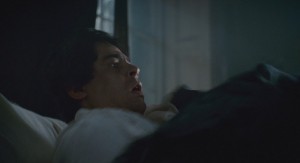 Notice that I said he’s perfectly cast as the Wolfman. That’s because he’s not well cast as the lead, Lawrence Talbot. Del Toro’s unconvincing wig, which is dyed jet black and awkwardly positioned, is not much of a help. But really, it’s the dark circles under his eyes – exhaustion, combined with his natural intensity — that causes the problem. Instead of seeing Talbot and the Wolfman as separate entities, we’re just getting only Lou Ferrigno for two hours and no Bill Bixby/David Banner.
Notice that I said he’s perfectly cast as the Wolfman. That’s because he’s not well cast as the lead, Lawrence Talbot. Del Toro’s unconvincing wig, which is dyed jet black and awkwardly positioned, is not much of a help. But really, it’s the dark circles under his eyes – exhaustion, combined with his natural intensity — that causes the problem. Instead of seeing Talbot and the Wolfman as separate entities, we’re just getting only Lou Ferrigno for two hours and no Bill Bixby/David Banner.
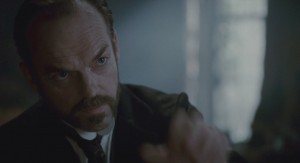 The only actor who overplays properly is Hugo Weaving, as a menacing and inquisitive Scotland Yard detective. He grits his teeth and seethes through every line.
The only actor who overplays properly is Hugo Weaving, as a menacing and inquisitive Scotland Yard detective. He grits his teeth and seethes through every line.
Anthony Hopkins, as Talbot’s estranged father, looks the most lost of all of the actors. There are moments where he’s wearing visible eye shadow. But that’s not a hint that he’s supposed to be a cross-dresser — it’s just a mysterious detail that the camera lingers on without explanation.
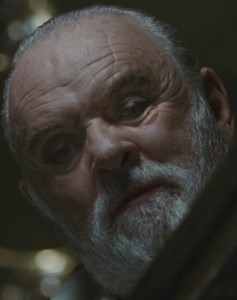
Mr. Hopkins put on the make-up himself.
The goofy and bizarre moments start to dwindle by the second half of the film, which is more generic and comparatively bland (much like other similar curiosities, such as Howard the Duck and On Deadly Ground). One exception is the fact that in the world of The Wolfman, full moons often occur three night in a row, as opposed to the once a month that those of us on Earth experience. Most of the second hour is comprised of the Wolfman jumping from roof to roof in search of victims, before climaxing with a wolf-on-wolf battle that heavily resembles the WWE-style battle at the end of Freddy vs. Jason.
 I doubt that emulating cheesy slasher movies was Johnston’s original intention. But there’s no way that the director who gave us studio-approved auteur nullification films such as Jumanji, The Rocketeer and Jurassic Park III okayed the Wolfman’s howl. It sounds exactly like the beginning of any number of disco records, or at the minimum Michael Jackson’s Thriller?**
I doubt that emulating cheesy slasher movies was Johnston’s original intention. But there’s no way that the director who gave us studio-approved auteur nullification films such as Jumanji, The Rocketeer and Jurassic Park III okayed the Wolfman’s howl. It sounds exactly like the beginning of any number of disco records, or at the minimum Michael Jackson’s Thriller?**
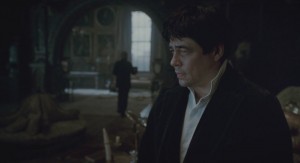 Maybe Johnson was fine with the sets and effects that look like video games (or more specifically, Pitof’s 2001 film Vidocq***)? Or that look like a hokey scene on a train with Max Von Sydow, where the editing is so sloppy that Del Toro’s wig doesn’t match from shot to shot? Or Blunt’s mix of troubled and panicked looks, which Del Toro somehow interprets as her “joy”?
Maybe Johnson was fine with the sets and effects that look like video games (or more specifically, Pitof’s 2001 film Vidocq***)? Or that look like a hokey scene on a train with Max Von Sydow, where the editing is so sloppy that Del Toro’s wig doesn’t match from shot to shot? Or Blunt’s mix of troubled and panicked looks, which Del Toro somehow interprets as her “joy”?
But the mix of enthusiastically nonsensical gore (How, exactly, did the Wolfman’s claw come out of his victim’s mouth?) and self-aware winkery suggests that — while staging the stodgy dinner scenes — Johnston was his mediocre self. But when the full moon makes its appearance, he transforms into the master of the ironically idiotic studio film — Sam Raimi.
 I bet that, on the set, Johnston hoped the transformation would have been permanent.
I bet that, on the set, Johnston hoped the transformation would have been permanent.
* One of the major arguments was apparently over Rick Baker’s effects and make-up work, with the studio wanting to exclusively use CGI for the transformation sequences. This was a strange reason to delay, considering Baker had already won six Oscars for makeup and effects. Those awards include one for one of the most impressive practical non-computer aided effects ever designed — the transformation scene in An American Werewolf in London.
 When effects delay a film for several years — or are at least officially blamed — one harkens back to the last time that that excuse was used for another enormously budgeted film, The Adventures of Pluto Nash.
When effects delay a film for several years — or are at least officially blamed — one harkens back to the last time that that excuse was used for another enormously budgeted film, The Adventures of Pluto Nash.
** Is it a reference to the fact that John Landis, who directed the video for Thriller, also directed An American Werewolf in London?
*** Vidocq was the first theatrically released movie shot on HD video, and is like watching 90 minutes of video game cut scenes.
P.S. If you want to see full versions of the most ridiculous screenshots, so you can really see what’s going in them, use the following links: Here
Here
Here
Here



